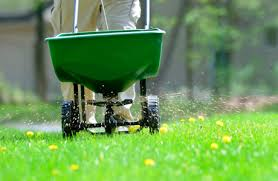 Few words strike fear into the heart of the average homeowner more than fertilizer. With complex terminology and numerous options, it is easy to see how someone can get overwhelmed. Learning the answers to some of the most common fertilizer questions will arm you with the knowledge you need to fertilize your lawn like a pro.
Few words strike fear into the heart of the average homeowner more than fertilizer. With complex terminology and numerous options, it is easy to see how someone can get overwhelmed. Learning the answers to some of the most common fertilizer questions will arm you with the knowledge you need to fertilize your lawn like a pro.
Why should I fertilize my lawn?
There are several reasons why you would need to fertilize your lawn. Over time, many lawns will leech nutrients out of their soil. Most nutrients for your lawn are water-soluble. Over time, whether through rain or irrigation, the water will carry these nutrients out of your lawn. This will leave your lawn nutrient deficient, which will leave you with an unhealthy lawn susceptible to disease. In some instances, the soil that the grass is growing in does not have the naturally occurring nutrients that turf needs to grow. If this is the case, fertilizer will be needed in order to maintain a healthy lawn. To determine whether or not your soil is nutrient deficient, you can purchase a soil test kit to learn more about the soil composition. The results of this test will help you determine exactly what type of fertilizer that your lawn needs.
What kind of fertilizer should I use?
This question alone is enough to make most homeowners break out in a cold sweat. They go to the store and see countless bags of fertilizer, all containing complex words and number ratios. Although it might look intimidating, most fertilizers are made up of three different nutrients: Nitrogen, Phosphorus, and Potassium. Each of these nutrients plays a different role in maintaining healthy lawns.
– Nitrogen promotes healthy leaf growth by encouraging the production of chlorophyll, which is a chemical vital to photosynthesis.
– Phosphorus helps your lawn develop healthy roots and stems.
– Potassium gives your lawn strength, helping it to resist drought and disease.
Most bags of fertilizer will have a 3 number ratio on the bag. These numbers are the percentages of nitrogen (N), phosphorus (P), and potassium (K), or N-P-K ratio, of the fertilizer. If a fertilizer is labeled 20-5-15, this means that it contains 20% nitrogen, 5% phosphorus, and 15% potassium. The remainder of the fertilizer is made up of inert materials and trace elements.
For your lawn, it is important to find a fertilizer with a high level of nitrogen. You want to promote and encourage growth! Although phosphorus and potassium are still important, your lawn needs them in smaller percentages than nitrogen. Another way to add nitrogen into your lawn, rather than fertilizer, is by leaving your grass clippings in the yard after mowing. Grass clippings are rich in nitrogen and mulching your lawn, rather than bagging the clippings, will help with your overall lawn health. However, large clumps of grass left after mowing are an eyesore and should be removed.
How should I apply the fertilizer to my lawn?
There are two different ways to apply fertilizer to your lawn: granular and liquid applications. Both of them have their benefits and drawbacks. Liquid fertilizer is diluted in water and spread over your lawn with a liquid fertilizer applicator. These types of fertilizers are fast acting, with results often visible within a few weeks. Liquid fertilizers, compared to granular fertilizers, are often cheaper to purchase. Although they work very well, these types of fertilizers also have a few drawbacks. These types of fertilizers have a higher chance of leaching when applied in high doses. They also require more applications than granular and there is a greater chance of “burning” your lawn with too much fertilizer.
Granular fertilizers, with their time released formula and high margin for error, are recommended for most home owners. Granular fertilizers are applied using a rotary spreader. These fertilizers take longer to show results than liquid fertilizers, but do not have to be applied as often. There is less of a chance of fertilizer leaching out of the soil and, because of its time release formula, less of a chance that you will “burn” your lawn by using too much fertilizer. Although these types of fertilizers are typically more expensive than liquids, the margin of error that they offer homeowners more than makes up for the higher cost.
When should I fertilize my lawn?
When you should fertilize your lawn often depends on the amount of time and money you want to spend on your lawn. Purdue University’s Department of Agronomy recommends a light fertilization in spring and early summer and a heavy application in the fall. Purdue has done extensive research on this topic and you can read more in depth information here.
If you have any questions about fertilizing your lawn, or are interested in learning more about our residential services, please call Engledow Group at (317) 575-1100 or fill out the form below.
Please select a valid form
